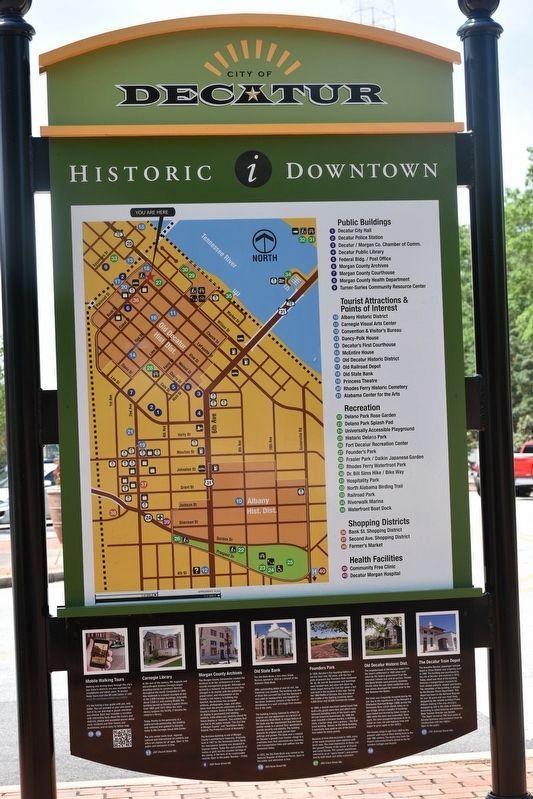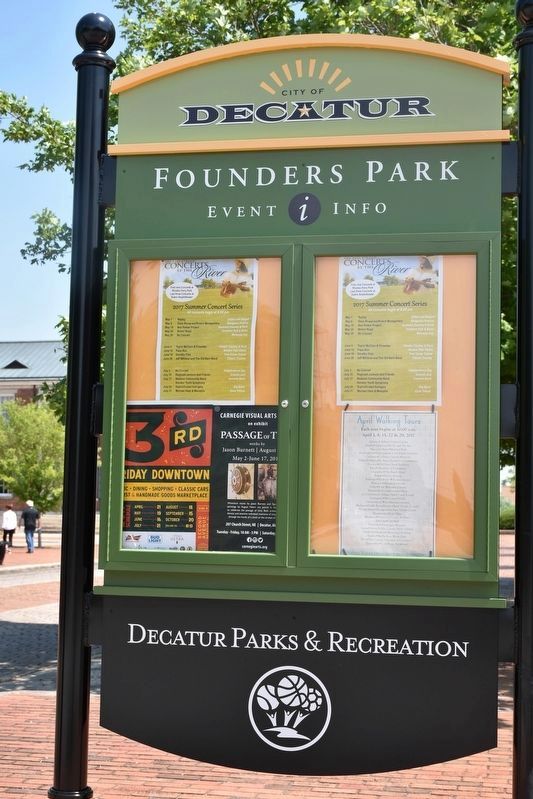Decatur in Morgan County, Alabama — The American South (East South Central)
Historic Downtown/Founders Park
Public Buildings
1. Public City Hall
2. Decatur Police Station
3. Decatur/Morgan Co. Chamber of Comm.
4. Decatur Public Library
5. Federal Bldg./Post Office
6. Morgan County Archives
7. Morgan County Courthouse
8. Morgan County Health Department
9. Turner-Surles Community Resource Center
Tourist Attractions & Points of Interest
10. Albany Historic District
11. Carnegie Visual Arts Center
12. Convention & Visitor's Bureau
13. Dancy-Polk House
14. Decatur's First Courthouse
15. McEntire House
16. Old Decatur Historic District
17. Old Railroad Depot
18. Old State Bank
19. Princess Theater
20.Rhodes Ferry Historic Cemetery
21. Alabama Center for the Arts
Recreation
22. Delano Park Rose Garden
23. Delano Park Splash Pad
24. Universally Accessible Playground
25. Historic Delano Park
26. Fort Decatur Recreation Center
27. Founders Park
28. Frasier Park / Daikin Japanese Garden
29. Rhodes Ferry Waterfront Park
30. Dr. Bill Sims Hike / Bike Way
31. Hospitality Park
32. North Alabama Birding Trail
33. Railroad Park
34. Riverwalk Marina
35. Waterfront Boat Dock
Shopping District
36. Bank St. Shopping District
37. Second Ave. Shopping District
38. Farmer's Market
Health Facilities
39. Community Free Clinic
40. Decatur Morgan Hospital
Mobile Walking Tours
Walking and driving tours throughout the city’s tow historic districts are now available for smartphones and tablet users. To access these tours scan into QR code below or visit www.DecaturAlabamaUSA.com/mobile
It’s like having a tour guide with you only better. You can proceed at your own pace by foot or by car and stop or pause whenever you choose. Each tour includes a narrative with interesting facts about the history and districts, photos and anecdotal stories about early residents and their homes and business, and an easy-to-follow map.
10 16
Carnegie Library
At the turn of the century, RR magnate and philanthropist Andrew Carnegie began donating money to construct libraries throughout the world. Completed in 1904, this landmark is a classic example of one of the 2,509 Carnegie buildings. Originally about 3,500 s.f. and costing $8,500, the building serves as Decatur’s public library from 1904 until 1973. When the main library outgrew the facility, it became the Children’s library.
Today, thanks to the generosity of a public/private partnership, the building was restored and updated to become home to the Carnegie Visual Arts Center.
The art center hosts local, regional, national and international art exhibits and offers art classes for all ages. Open to the public and admission is free.
11 (207 Church Street NE)
Morgan County Archives
The Morgan County Commission created the Archives to be the centerpiece of a new records management program. Although not primarily a museum, the Archives was also charged in its charter with the gathering, preservation, and interpretation of the County’s rich history. In fulfilling this function, the Archives has accepted artifacts, photographs, maps, and other items from the private collections of the County’s citizens. Some of these items are on display in permanent and rotating exhibits, while others are carefully stored for future display or research. Two exhibits that are free to the public include “The Cicil War in Morgan County” and “Scottsboro Boys: Outside the Protective Circle of Humanity”.
The Archives building is one of Morgan County’s architectural treasures. Originally built in 1927 for the Tennessee Valley Bank, the neoclassical building was designed to impress visitors. Today the vault protects no money or gold, but the valuable heritage of the county, I the form of its irreplaceable records. Open to the public Monday-Friday.
6 (624 Bank Street NE)
Old State Bank
The Old State Bank, a two-story Greek Revival, opened in 1833 as a branch of the Alabama State Bank.
After outstanding debts of over $1mil., the franchise was revoked. The building was one of three that survived the Civil War because it was used as headquarters and hospital for the Union. Evidence remains in the from of bloodstains in a vault and slugs from musket fire int he walls.
The building is being restored to reflect its original use and appearance as a branch of Alabama State Bank. A Iquique feature of the bank was the requirement that the head cashier reside in a second-floor apartment to provide security and stability. The building features its original vault, period room settings and garden. The bank was a catalyst for Decatur’s growth from frontier village to a creditable town that welcomed new business, vital transportation line and settlers into the Tennessee Valley.
In 1972, the Old State was name to the National Register of Historic Places. Open to the public and admission is free.
18 (925 Bank Street NE)
Founders Park
In 1820, Decatur’s five founding fathers laid out the town into 162 plots, with the four plots of present day Founders Park numbered 42, 43, 48 and 49. Businesses and dwellings were located here, but were torn down by Union troops during the Civil War when a fort was built in the location of this sign. During the 1864 Battle of Decatur, this area was in the middle of the fighting involving about 5,000 Union and 25,000 Confederate troops.
In 1869 a Jewish merchant named Louis Falk built a dry goods store here and others soon followed including many of the town’s early African American businesses. By 1898 the area included a Chinese laundry, a clothing store, a barber shop, and a grocery — the first building. Known as the White Building, it is eventually was uses as one of the town’s first hotels for black guest.
Because of fires that occurred in 1900, many of the wood structure were replaced with brick ones. The most impressive of these was the Lyceum Theater at the corner of Church and Canal Streets. The Lyceum (sometimes referred to as an “opera house”) was patronized by both black and white customers.
27 (907 Canal Street NE)
Old Decatur Historic Dist.
The neighborhood of Old Decatur dates form the town’s settlement in 1820 when land taken by the federal government from the Cherokee Indians was sold at auction. Market and Bank Streets were primarily business streets while the oak-lined residential area was slowly developed for homes prior to the War Between the States.
The town was frequently occupied during the war due to the significance of the Memphis & Charleston Railroad Bridge (1856) across the Tennessee River which stands today as an iron bridge. All but a handful of buildings were looted and leveled by Union troops in 1864, while the town was evacuated. Once again, the town prospered because of its location on river, rail and highway lines and began to grow in the 1870’s.
The house range in age from 1829 to the present, with most of them dating back to the late 19th century. The styles vary from the French-influenced Empire period to the Edwardian Cottage and beyond.
16
The Decatur Train Depot
The beautiful Decatur passenger railroad depot or Union Station was originally built in 1905. The building was purchased by the city of Decatur and restored in 2015. Today, about one-third of the building features a transportation museum for train related artifacts, models and history. The remainder of the building is utilized by the Decatur Police Department. This depot has been on the National Register for over 30 years and was most likely designed by the notable architect Frank Milburn making it the only structure designed by him in the state of Alabama. According to noted historian and Alabama State Tourism Director, Lee Sentell, “The Depot served as THE local point of Decatur business and commerce from its construction until the 1950’s”. Open to the public.
17 (701 Railroad Street NW)
Erected by City of Decatur.
Topics. This historical marker is listed in these topic lists: Architecture • Industry & Commerce • Railroads & Streetcars • Settlements & Settlers • War, US Civil.
Location. 34° 36.823′ N, 86° 59.043′ W. Marker is in Decatur, Alabama, in Morgan County. Marker is at the intersection of Bank Street NE and Church Street NE on Bank Street NE. Touch for map. Marker is at or near this postal address: 925 Bank Street NE, Decatur AL 35601, United States of America. Touch for directions.
Other nearby markers. At least 8 other markers are within walking distance of this marker. Old Decatur Historic District / Old State Bank (a few steps from this marker); To Commemorate the Passage of The Olympic Torch (a few steps from this marker); Rising Sun Lodge No. 29 (within shouting distance of this marker); Old State Bank Building (within shouting distance of this marker); Battle of Decatur (within shouting distance of this marker); Decatur and The Civil War in North Alabama (within shouting distance of this marker); Hood’s Middle Tennessee Campaign and The Battle for Decatur (about 300 feet away, measured in a direct line); Two Bridges Across The Tennessee River (about 400 feet away). Touch for a list and map of all markers in Decatur.
Credits. This page was last revised on June 4, 2017. It was originally submitted on May 5, 2017, by Sandra Hughes Tidwell of Killen, Alabama, USA. This page has been viewed 510 times since then and 52 times this year. Photos: 1, 2. submitted on May 5, 2017, by Sandra Hughes Tidwell of Killen, Alabama, USA. • Bernard Fisher was the editor who published this page.

